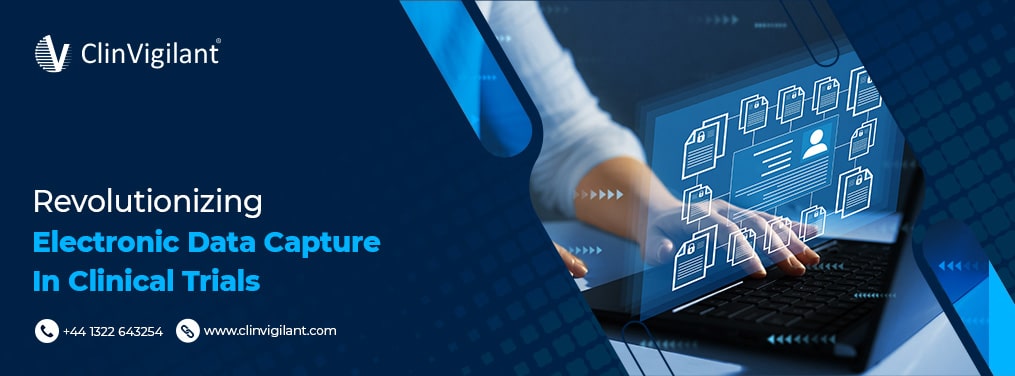
Electronic data capture (EDC) has transformed how clinical trials are conducted and managed. By digitizing and streamlining data collection, EDC provides immense value for clinical trial sponsors, sites, and participants. In this blog post, we’ll explore what EDC entails, its tangible benefits, the technical approach behind it, challenges, results and outcomes achieved so far, and how it is shaping future trials.
What Is Electronic Data Capture In Clinical Trials?
Electronic data capture in clinical research (EDC) refers to the process of electronically collecting clinical trial data and transferring it to a central database. It replaces the traditional paper-based data collection. With EDC, patient data that would traditionally be captured on paper source documents are instead entered electronically.
This data can include patient demographics, medical history, observations from site visits, pharmacokinetic parameters, safety reports, quality of life questionnaires, and more. The data is entered through an intuitive interface and stored in a centralized, cloud-based database that offers advanced analytics and dashboards.
EDC platforms offer study designers the flexibility to build eCRFs (electronic case report forms) tailored to their specific study requirements. Forms can include drop-downs, calendars, slider scales, and branching logic to improve accuracy and efficiency. EDC allows clinical trial data to be captured, cleaned, standardized and transmitted in real-time to sponsors and regulators.
Benefits Of Electronic Data Capture In Clinical Trials
Compared to paper processes, electronic data capture provides tremendous advantages:
- Improves accuracy – EDC includes data validation checks that prevent incorrect or inconsistent data from being entered. Edit checks and range checks further enhance quality.
- Accelerates data availability – Being digital, data becomes available for review and analysis instantly without delays in the source document retrieval and delivery that plague paper processes. Rapid access allows quicker insight.
- Enhances efficiency – By eliminating duplicate data entry and enabling bulk uploading of digital devices, EDC for clinical research saves significant time and effort over manual paper handling. This frees up staff for more value-adding tasks.
- Reduces cost – The savings from faster closeouts, improved productivity, minimized corrections outweigh the IT costs for EDC software and hardware infrastructure. EDC is increasingly affordable with the availability of cost-effective SaaS solutions.
- Supports compliance & inspection readiness – EDC’s impeccable audit trails capture detailed evidence on trial processes such as user actions, data modifications, queries, and related communications. This documented transparency is invaluable during regulatory inspections while also supporting compliance throughout.
- Enables risk-based monitoring – The availability of real-time data allows sponsors to perform central statistical monitoring to rapidly detect anomalies and focus limited on-site efforts only on higher risk issues, enabling optimally efficient oversight.
- Facilitates amendments – Any updates to study protocols get reflected instantly in the eCRF templates. This keeps data collection aligned with the latest procedures without site delays common with distributing paper amendment updates.
- Simplifies system migrations – Transitioning studies across IT systems or sponsors is smoother due to standardized data formats like CDISC ODM used by EDC systems that retain metadata and audit trails.
The merits of EDC are compelling, with adoption exceeding 94% across trials. Electronic data capture delivers gamechanging improvements in quality, productivity and cost savings that benefit all trial stakeholders.
Technical Approach To Electronic Trial Master File In Clinical Trials
The electronic trial master file (eTMF) is a core component of clinical trial data management alongside EDC. As trials become entirely digitalized, the eTMF provides centralized organization and control of critical documents and trial correspondence. Just as EDC improves collection and management of study data, eTMF revolutionizes document control which has traditionally relied on physical files and storage units.
Sponsors can choose between software eTMF solutions provided by external vendors or create eTMF functionality internally within their existing IT systems. The system architecture typically consists of a document repository along with supporting metadata, an audit trail, reporting engine, and user access controls.
Documents get submitted from global participating sites and processed to the standardized TMF index structure, with automated techniques to classify records for organizing within specified folders. Centralized access is available 24/7 globally to authorized users through a portal that enables TMF document searches, bookmarks, color coding and real-time inspection readiness dashboards.
Digitization provides immense efficiency in locating records quickly, while tighter controls reduce errors like misfiling or temporary separation of documents from the complete TMF record seen in manual handling. Automated tracking and alerts improve oversight and coordination of document flow. Study teams save significant time previously spent on physical document transfers and associated compliance checks. The eTMF is truly revolutionizing management while increasing the transparency and control sponsors have over their vital trial documentation.
Challenges of Electronic Trial Master File In Clinical Trials
Implementing an eTMF also poses some unique challenges:
- Transition barriers – Sites can lack experience for paperless processes or face technology limitations regarding eTMF solutions. User training and change management is crucial.
- Integration complexity – Connecting site source systems with the eTMF and EDC platforms can require significant IT coordination and testing. The effort rises further in decentralized models allowing site access to these core data systems.
- Standardization needs – High document volumes make it infeasible to manually classify individual records. Automated categorization of unstructured content using AI/ML techniques is an emerging solution, but not yet mature.
- Audit preparedness – While eTMF enhances inspection readiness through better document control, reviewers may still prefer physical records. Printing key content remains necessary.
- Dependency risks – High availability needs for always-on eTMF access brings infrastructure dependencies that may impact stability. Failover and disaster recovery protections are a must.
These challenges underscore how revolutionary eTMF solutions still involve some process change management. However, the risk is outweighed by tremendous efficiency gains, better study control, and access advantages for this mission-critical study asset.
Results & Outcomes: Electronic Data Capture In Clinical Trials
Over 25 years since the first EDC for clinical research implementation, electronic data capture for trials has seen massive adoption and delivered extensive tangible and intangible results including:
- Up to 50-80% faster database lock for accelerated analysis
- ~30% reduction in data queries through better data quality
- ~40% faster site payments by eliminating handling of paper forms
- 30-80% lower monitoring costs allowing targeted resource optimization
- 50-70% improvement in inspection audit findings through inherent compliance
- 92% sponsor satisfaction with EDC usability by site users
- 99% data accuracy and 21 CFR Part 11 compliance in multi-center EDC studies
- 3X increase in clinical trial efficiency reported by sponsors
For a field centered around evidence, the results provide compelling proof. EDC has been integral to productivity gains that enabled the 50% rise in annual FDA drug approvals in recent years despite static R&D budgets. With higher quality and good data practice compliance inherently built-in, EDC has been a gamechanger for trial credibility and efficiency.
Clinical Trials in the Future: How Electronic Data Capture is Transforming Research
The clinical trial landscape will continue its rapid technology-led transformation going forward. Upcoming innovations in electronic data capture span multiple dimensions:
Smarter Systems – Emerging ‘no-code’ EDC platforms enable intuitive form building and modifications without specialized IT skills. Cloud infrastructure and open APIs enhance extensibility and scalability. Inbuilt business intelligence surfaces real-time analytics dashboards. Integrated eSource and eConsent modules complete end-to-end digitization.
Decentralized Trials – Direct-to-patient capabilities like virtual video visits and telemedicine, combined with at-home assessments via connected wearables, ingestible sensors, and apps transform trials from site-based to virtual. EDC systems readily support this model with patient portal access, ePRO instruments, and mHealth data integrations.
Real World Evidence (RWE) – Linking EHR and claims data from routine care to EDC databases provides invaluable context about patients and treatments. Augmenting protected health information (PHI) with deep clinical trial evidence will gain regulatory trust to incorporate RWE in decision making.
Artificial Intelligence – AI techniques help unlock insights from unstructured content like medical images, physician notes, and biomarker assays to provide supplementary endpoints. Natural language processing automates text conversions. AI will also refine data checks, site selection algorithms and predictive trial analytics.
As pioneering options emerge, EDC systems provide the foundational data capture layer upon which such cross-functional innovations can be readily enabled. Already specialty solutions exist for trials in genomics, oncology, rare diseases and more with prebuilt disease ontologies and genomic data modules.
Ultimately participants will benefit the most from these advances through safer, targeted treatments, shorter trials and care innovations driven by deeper insights from higher quality, integrated trial evidence.
Conclusion
The clinical research enterprise has reached an inflection point with technology modernization through EDC leading the transformation. By enabling trial innovations like decentralized designs, real world data integration and precision analytics, yet simplifying implementation using cloud platforms and intuitive interfaces, electronic data capture has bolstered productivity while unlocking tremendous new possibilities.

